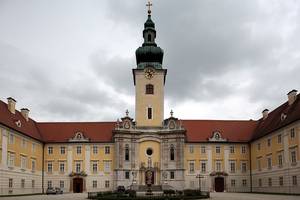Seitenstetten Monastery

Seitenstetten Monastery is an abbey of the Benedictines, who arrange their spiritual, social and personal lives according to the strict monastic rule of Benedict of Nursia from the 6th century. “Ora et labora!” or “Ora et labora et lege” are the concise instructions of the monastery founder.
Starting from Montecassino Monastery in Central Italy, the Regula Benedicti was taken over by a lot of other European abbeys, in many cases at their worldly donators’ request. The strengthening of the abbeys and their connection with the mundane power in many places led to a moral collapse of the monastery life. The counter movements like the reform starting from the Burgundian Benedictine abbey Cluny in the 10th century or the “Melker Reform” after the Council of Constance in the 15th century were intended lead to a revival of the old Benedictine principles. These prinicples mainly build on reliability in the community, monastic lifestyle and obedience, demanding pursuit of human entity through abstinence, mental contemplation and avoidance of all kinds of excesses. Until today, the abbeys of the Benedictines act as centres of culture and education and are housing significant libraries. Among the long-standing Benedictine secondary schools of Austria are the ones in Admont, Kremsmünster, Melk, Seitenstetten and the Vienna Schottenstift.
Seitenstetten Monastery was founded in 1112 by Udalschalk, a local nobleman, who addicted his inheritance property in the area of Seitenstetten to the abbey. After a slow upturn and a longer period of decline, Abbot Benedict l. implemented the reform of Melk, thus effecting another religious and cultural upturn. Abbot Benedict ll. Abelzhauser built up the pilgrimage church dedicated to the St. Trinity on the nearby Sonntagberg and in the years 1718-1747 the monastery got its today baroque shape. The decades after Emperor Joseph ll. and the wars against the French were a very prosperous period for the abbey. Today, the whole monastery building has been restored and appears in new brilliance. Especially worth seeing is the baroque monastery garden, where concerts, festivities and annual garden days take place.
Seitenstetten Monastery Library possesses 90 000 volumes, 277 incunabula, 270 medieval handwritings and a globe collection. The Monastery Archive comprises 1253 documents from the 12th century, about 700 profession documents beginning from the 14th century, 1100 codices, 450 briefcases, 700 plans and a big picture archive. Besides, the archive is in possession of volumes of the lordships of Seitenstetten and Yppsitz, territory books, housekeeping books from the 17th-19th century, and others.
Sources:
www.stift-seitenstetten.de; www.kulturgueter.kath-orden.at/benediktinerstift-seitenstetten
Image source:
http://commons.wikimedia.org/wiki/File:Stift_Seitenstetten_20110731-8.JPG?uselang=de





